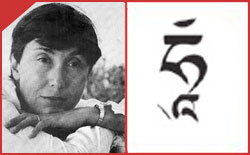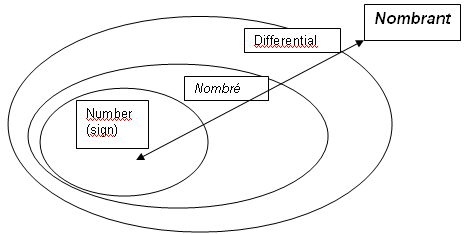Available Languages
- Consultez cette page en FRANÇAIS
- Consult this page in ENGLISH
Semanalysis. Engendering the formula
By Johanne Prud’homme and Lyne Légaré
Université du Québec à Trois-Rivières
1. Abstract
Kristeva

According to Julia Kristeva, the text is an "energized" object. Following Bakhtin's thesis on dialogism, Kristeva (1969, 217) postulates that "what we call "literary" work is manifested in our times as text [...]. These are productions that call for [...] a theory, and this theory must be developed through an analytical linguistic approach to the signifier-emerging as text." Because structural semantics is too Cartesian to define the movements of the signifying process [signifiance], semanalysis diverges from it in an effort to reveal the "signifier-emerging as text" (Kristeva, 1969, 217) by considering "the sign as the mirror (reflective) element engaged in the representation of this engendering [...]" (Kristeva, 1969, 218). Following this idea, Kristeva develops a typology of textual signifiance based on that of mathematical logic, which eludes "stasis" due to the freedom of its signs.
This text may be reproduced for non-commercial purposes, provided the complete reference is given:
Johanne Prud’homme and Lyne Légaré (2006), « Semanalysis. Engendering the Formula », in Louis Hébert (dir.), Signo [online], Rimouski (Quebec), http://www.signosemio.com/Kristeva/semanalysis.asp.
2. THEORY
The intent of Julia Kristeva's semanalysis is to reveal the dynamics of the signifying process [signifiance]. The expression "engendering the formula" aptly illustrates the motile nature of the "signifier-emerging as text" (Kristeva, 1969, 217): the specific sign whose function is to represent this engendering, which we will follow step by step.
2.1 PRELIMINARIES TO THE CONCEPT OF THE TEXT
In the context of mathematical logic, textual signifiance can be thought of as a logical-mathematical formulation to describe the "successive reshapings and reweavings of the web of language" as they take place in the text (Kristeva, 1969, 225). Understood as an open formula, the text exhibits a continual oscillation between the pheno-text and the geno-text and back, and it establishes "the notion of a structure emerging within the actual substance of the structured [...]" (Kristeva, 1969, 224).
NOTE ON PHENO-TEXT AND GENO-TEXT
The distinction between the terms "pheno-text" and "geno-text" was borrowed from Šaumjan Soboleva.
2.2 THE PHENO-TEXT
From the Greek phainesthai, « pheno » means "to appear". The term "pheno-text" refers to the text as a "fact" or an "appearing" in its concrete manifestation or material form (communicative function). It is the site where a space for the process of engendering meaning is embodied in a concrete medium. It acts as the focalizing point of the signifying process. The printed text is where the production of meaning is momentarily suspended.
2.3 THE FORMULA
"For the formula, being a trap/illusion [leurre], is embodied in a form [the pheno-text] that can confront the mirror and see itself there. What is seen must then ricochet back to renew germination, divide it in order to transform it, and thereby stop it in preparation for some new, other formula [...] (Kristeva, 1969, 225).
The pheno-text is not a two-dimensional structure, despite the finite nature of the printed text, however, and this is because it contains the specular element (the "mirror effect") of its own engendering (germination, or production of meaning) in what we call "the formula". As the springboard and fountainhead of the signifying process, the formula keeps the pheno-text from creating a finite meaning, since in order to gain access to the text (make it readable), the formula requires us to trace it back to its genesis. As a temporary holding place for signifying combinations that can always be reformulated, the formula looks like a corollary remainder (indicating a reciprocal relationship), a point of impact, or an accident in the vast workings of the geno-text moving through it. The formula is an overdetermined point of the geno-text; that is, it represents the reduction of meaning in a given context.
2.4 THE GENO-TEXT
"Unstructured and unstructuring, the geno-text has no knowledge of the subject" (Kristeva, 1969, 223).
From the Greek genêtikos, "geno" represents that which is "specific to generation", in the sense of "genesis" and "production". The geno-text corresponds to the process of generating the signifying system (the production of signification). It is the locus of all possible signifiers in which the formulated signifier of the pheno-text (the formula) can be situated, and thus, overdetermined. All of the possibilities of language (the symbolic process, the ideological corpus, the language categories) are arrayed there before precipitating out in some formula in the pheno-text. The geno-text is not a structure; it represents signifying infiniteness. The geno-text does not reveal a signifying process; it offers all possible signifying processes [signifiances].
Diagram of the textual signifying process
GENO-TEXT |
Symbolic |
Ideological |
|
Language categories |
|
|
|
|
|
|
|
PHENO-TEXT |
Formula |
|
2.5 THE SIGN'S NUMERICAL FUNCTION
From the very beginning, the number has always seemed to be a notch in the infinite array of numbers. Ordination is recognized as the main function of the number. Like the sign, it is presented as a perceptible unit; however, it always functions like a measurable multiplicity (the number arranges order while referring back to the plurality of numbers). Drawing an analogy between the number and the sign allows us to reach "a new space of reversible and recombinant sites, the space of signifiance" (Kristeva, 1969, 218). "As it delves into the sign, semanalysis first detects the infinite nombrant, which has a nombré associated with it (the graphic and phonic ensembles), before it comes up with a referent or a signified with which to make a sign" (Kristeva, 1969, 233). This action of the signifier, which Kristeva described as paragrammatic, allows us to find the signification "through a signifier torn asunder by an insistent meaning in action" (Kristeva, 1969, 231), just as in Saussure's anagrams.
2.6 THE NUMBER-SIGN
The number-sign is a defining point in differentiated infinity (a suspension of the signifying process), and it has to have a structuring function since it creates the closed signifier; it is the "place where infinite space is converted into duration-finiteness" and it "sets up time as a way of intercepting (immobilizing) a frequency as measurable" (Kristeva, 1969, 235).
2.7 THE NOMBRANT
The nombrant is the signifying infiniteness composed of all graphic and phonic units. It corresponds to "all of the once and future possibilities of linguistic combination, the unlimited resources of the signifier as different languages and different signifying practices have used or will use them" (Kristeva, 1969, 232). The nombrant is the vast space of signifiance in which all possible combinations (graphic and phonic) move around, never becoming fixed.
2.8 THE NOMBRÉ
The nombré is the graphic or phonic ensemble that acts on the uttered line as a point of impact within the infinite nombrant. Like the formula at the text level, it acts at the level of the sign as a point of impact in the signifying space of the nombrant. As a graphic or phonic combination making meaning in a given context, it constantly evokes the infinite array of possible combinations. It is an overdetermined point of the nombrant.
2.9 THE SIGNIFYING DIFFERENTIAL
"Leibniz's differential calculus is what restores infiniteness to the exiled signifier. Its infinitesimal nature reinstates the number's infinite-point function, which is the distinguishing feature of this symbolic actant, and turns it into the mark that in scientific notation actualizes the entire space within which the signifier moves" (Kristeva, 1969, 236).
The signifying differential corresponds to the infinite array of the nombré's current signifiers. Since it pertains to the nombré (of a given combination), it covers a more restricted space than the nombrant (which is not determined by any context). And since it evokes (and tends toward) signifying infiniteness nonetheless, it inscribes the multiplicity of signification into the ultimate meaning of the sign (the number-sign). It is the space in which the signifier moves; it is "infinity [the geno-text] slipping through to within the closed utterance [the pheno-text]" (Kristeva, 1969, 236). By inserting infinity into the closed utterance, the signifying differential is what enables the sign to not establish a finite meaning.
2.10 THE COMPOSITION OF THE SIGNIFYING DIFFERENTIAL
The following elements compose the signifying differential:
- Every meaning that can be covered by a phonic or graphic set (its homonyms).
- Every meaning that is identical to the signified(s) of this set (its synonyms).
- Every homonym and every synonym of this set, not just in one language, but in all languages to which it belongs as an infinite point.
- Every symbolic acceptation in the various mythical, scientific, and ideological corpuses.
The following diagram illustrates the signifying differential as it is formed from the defining point of differentiated infinity, the number-sign.
Diagram of the signifying process of the sign

3. APPLICATION
Let us take a measurable unit actualized in the pheno-text (that is, a number-sign)): the French possessive "son".
The nombré – the graphic and phonic combination active at the Formula level – is the following: s-o-n.
This nombré generates several possible combinations that, in the textual context, will make up the signifying whole, or nombrant, which Kristeva also refers to as the "infinite nombrant" (Kristeva, 1969, 233). The latter corresponds to the infinite array of graphic and phonic combinations and the unlimited resources of the signifier as it acts at the level of the geno-text. In the case we are considering, the multiplicity of signification generated by the French possessive number-sign "son" – its signifying differential – can be shown in the different possible combinations that the nombré generates.
Homonyms: "son [sound]" (auditory sensation), "son [bran]" (grain), etc.
Synonyms: "sien [his, hers]"
Symbolic acceptations
"son" (possessive modifier): "belonging to a person", "belonging to an object", "belonging to an indefinite", etc.
"son [sound]" (auditory sensation): "phoneme", "noise", "tone", "ring", "pronunciation", and so forth.
"son [bran]" (grain): "milling", "tache de son [freckle]", etc.
4. LIST OF WORKS CITED
- KRISTEVA, J., "L’engendrement de la formule", Semeiotike : recherches pour une sémanalyse, Paris, Seuil, 1969, p. 216-310. [All quotes were translated from the original.]
5. EXERCISES
By associating the number-sign with its differential, we can reveal the space within which the signifier moves, a space that approaches signifying infinity. Establish the signifying differential for the following words and for each one, create a sentence in which the signifying potential of the number-sign is revealed through a word play.
Point

Oar

Alter


